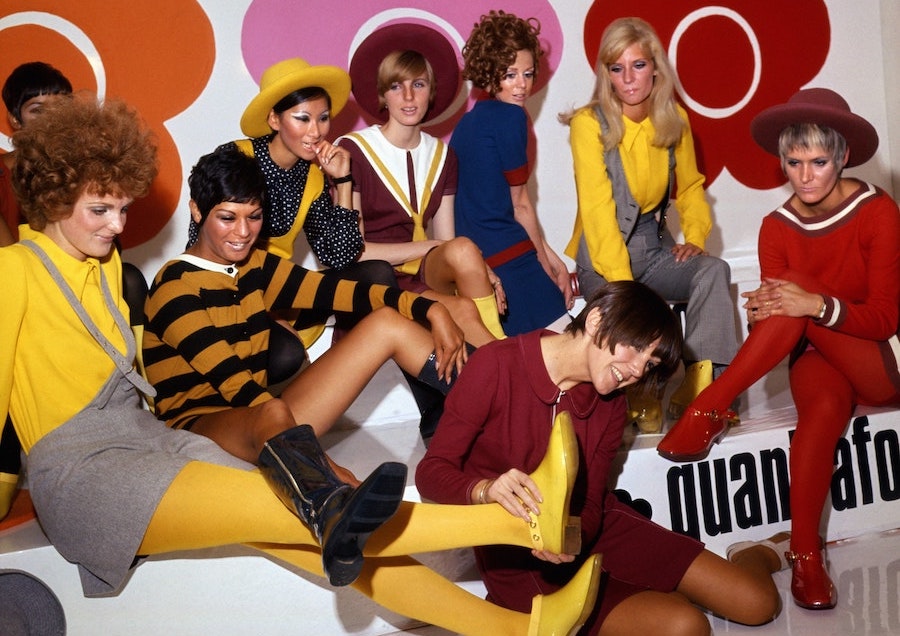How Mary Quant changed the face of fashion
Mary Quant may be instantly recognisable for her ginger bob, but it’s her youthful mod designs that she’ll be forever remembered for.
Looking back at her influence, it’s clear Quant’s impact was far greater than just bringing miniskirts and hot pants into the mainstream – her impact on the fashion industry and society as a whole really can’t be understated.
Walking through the Victoria & Albert’s latest exhibition, which is dedicated to the designer’s career between 1955-1975, brings the extent of this impact to life. Now aged 89, Quant’s designs – and her ethos – are as relevant today as they were back in the Swinging Sixties.
Born in London to Welsh parents in 1930, Quant grew up in an age of austerity – but her designs were an antidote to this, championing fun, frivolity and women’s liberation. She set up her first store, Bazaar, on the King’s Road in London’s Chelsea in 1955, and her fashion and lifestyle empire only grew from there.
A true titan of the industry, here are just some of the ways Quant revolutionised fashion…
She was a role model for young women

Quant gave rain macs a Sixties update with the help of PVC
Quant’s clothes struck a particular chord with young women who, like the designer, were children of austerity who wanted to enjoy life a bit more than the generation before them. Her style was playful and fun – she riffed on the tweed suits her customer’s mother wanted her to wear by raising hemlines and making everything a whole lot more youthful.
Unlike many of the more traditional fashion houses, Quant wasn’t catering for the old elite – instead, she encapsulated exactly what it was like to be a young woman in the 1960s. As a female professional excelling in a male-dominated industry – to this day, many of the major fashion designers are men – she was inspiration for a new generation of working women.

Mary Quant made waves by accepting her OBE in a miniskirt in 1966
She was the first designer to use PVC, they shiny, wet-look synthetic material. The result was clothes which were young, daring and just a bit sexy – which was counteracted by the schoolgirl style she favoured, with Peter Pan collars galore.
Quant certainly knew her audience – one of her ad campaigns was entitled ‘Youthquake’, showing just who she wanted to dress. She ended up trademarking the daisy symbol, which signified youthfulness and fun. And while Quant might not have invented the miniskirt, she certainly helped it become the defining garment of the decade.
She was a feminist icon

Miniskirts make a big appearance in the V&A exhibition
The fashion industry predominantly caters to women, and yet the designing of womenswear is monopolised by men. Past exhibitions at the V&A have been dedicated to the likes of Christian Dior, Cristóbal Balenciaga and Alexander McQueen – titans in the industry, but all men.
Quant managed to break the glass ceiling which still exists for female designers, but this wasn’t the only way she was a true feminist hero. In the late-Sixties and early-Seventies, the women’s liberation movement exploded into the mainstream, and with it came various social shifts. Things were increasingly opening up to women in the UK – the Pill became available and society’s expectations of how women should dress were also changing.

Satin mini-dress and shorts by Mary Quant photographed in 1966
Her designs were a way for women to express their independence – she famously liked shorter hemlines because it made it easier to run to the bus. Hers weren’t clothes made to restrict the wearer, but to give them more freedom – Quant favoured a stretchy, wearable jersey material for many of her designs.
She was also ahead of the curve in terms of androgynous dressing and constantly played with masculine tailoring. With ultra-girly miniskirts as well as more tailored suits, Quant showed that women didn’t have to express themselves in a singular way.
She made fashion more widely accessible

Mary Quant pictured in 2007
Quant was a breath of fresh air in the fashion industry. This was a time when Paris was seen as the fashion capital of the world, with an emphasis on haute couture and uber-expensive garments. These clothes were beautiful, but wholly unattainable for most women.
Not only did Quant manage to shift more of the world’s focus on London, but she also worked hard to bring fashion to a wider group of people. As well as her eponymous high-fashion label, in 1963 she launched a cheaper diffusion line, called Ginger Group. With this, she pioneered new methods of production to make her designs cheaper and more widely available for the average woman.
On top of this, she sold sewing patterns (known as Butterick patterns) so home dressmakers could recreate her clothes with their own materials for a fraction of the price.
Mary Quant became the template for the modern lifestyle brand

Quant pictured with models showing off her new footwear line in 1967
A retrospective like the V&A’s exhibition shows how Quant was a pioneer in more ways than one. Nowadays, the fashion industry loves a bit of nostalgia – whether it’s bringing back chokers from the Nineties or power shoulders from the Eighties. Quant was an early adopter and knew how to harness the power of bygone styles, giving Victorian outfits a Sixties update and even bringing back flapper styles.
Another thing she became the template for was becoming a broader lifestyle brand. Today, fashion brands rarely do just one thing, instead in a race to diversify their offerings. Quant knew she could capitalise on her brand, so instead of just sticking to designing miniskirts, she tried her hand at everything from cosmetics and tights, to underwear, shoes and home furnishings.
Quant’s style was instantly recognisable and easily translated to other products, making her the true template for the modern lifestyle brand we’re so accustomed to today.
Mary Quant is on display at the Victoria & Albert Museum until February 16, 2020. See vam.ac.uk.
The Press Association
Latest posts by The Press Association (see all)
- How to keep your money safe – as criminals ramp up AI tactics to steal consumer data - April 16, 2024
- What are heat pumps and could they help your home save energy? - April 15, 2024
- Trailer for Bridgerton season three teases new friends-to-lovers romance - April 12, 2024
- A decluttering expert explains how to sort out your finances while spring cleaning your home - April 12, 2024
- 3 healthy air fryer recipes you can make in under 30 minutes - April 12, 2024





















